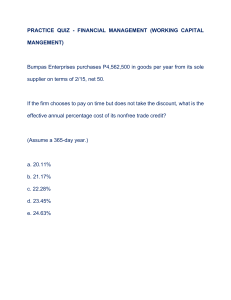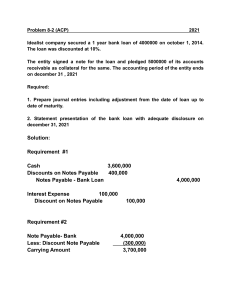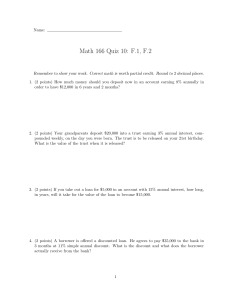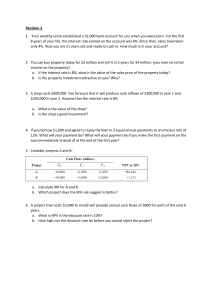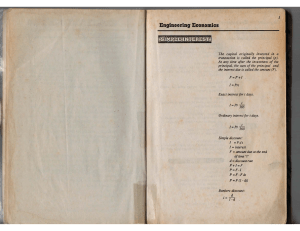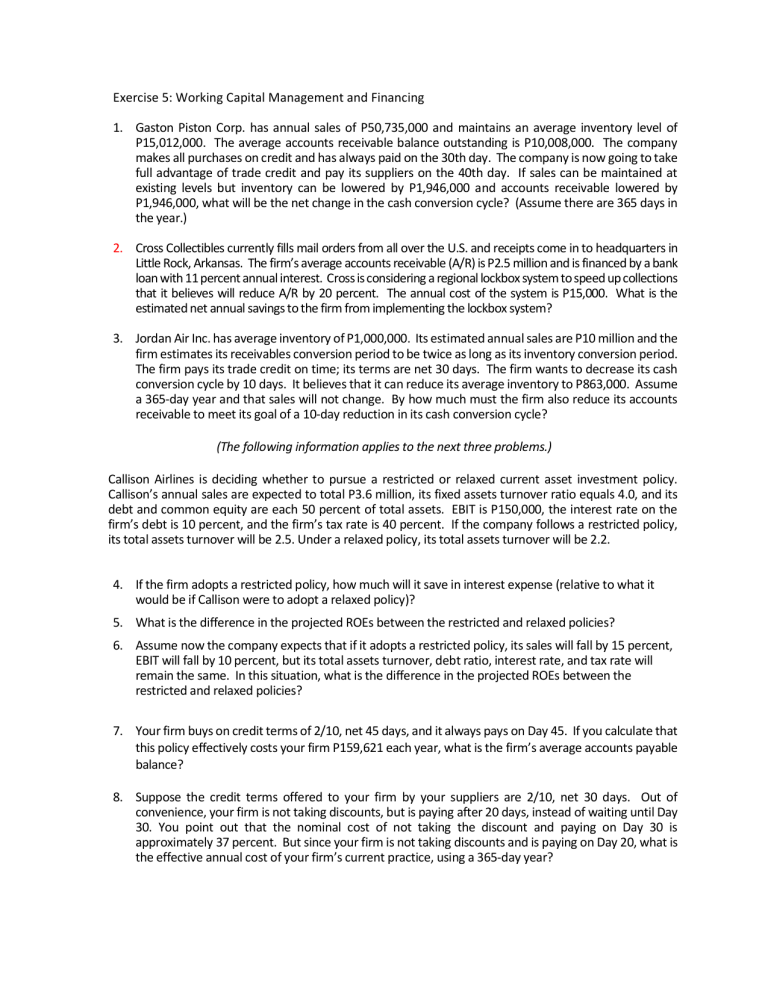
Exercise 5: Working Capital Management and Financing 1. Gaston Piston Corp. has annual sales of P50,735,000 and maintains an average inventory level of P15,012,000. The average accounts receivable balance outstanding is P10,008,000. The company makes all purchases on credit and has always paid on the 30th day. The company is now going to take full advantage of trade credit and pay its suppliers on the 40th day. If sales can be maintained at existing levels but inventory can be lowered by P1,946,000 and accounts receivable lowered by P1,946,000, what will be the net change in the cash conversion cycle? (Assume there are 365 days in the year.) 2. Cross Collectibles currently fills mail orders from all over the U.S. and receipts come in to headquarters in Little Rock, Arkansas. The firm’s average accounts receivable (A/R) is P2.5 million and is financed by a bank loan with 11 percent annual interest. Cross is considering a regional lockbox system to speed up collections that it believes will reduce A/R by 20 percent. The annual cost of the system is P15,000. What is the estimated net annual savings to the firm from implementing the lockbox system? 3. Jordan Air Inc. has average inventory of P1,000,000. Its estimated annual sales are P10 million and the firm estimates its receivables conversion period to be twice as long as its inventory conversion period. The firm pays its trade credit on time; its terms are net 30 days. The firm wants to decrease its cash conversion cycle by 10 days. It believes that it can reduce its average inventory to P863,000. Assume a 365-day year and that sales will not change. By how much must the firm also reduce its accounts receivable to meet its goal of a 10-day reduction in its cash conversion cycle? (The following information applies to the next three problems.) Callison Airlines is deciding whether to pursue a restricted or relaxed current asset investment policy. Callison’s annual sales are expected to total P3.6 million, its fixed assets turnover ratio equals 4.0, and its debt and common equity are each 50 percent of total assets. EBIT is P150,000, the interest rate on the firm’s debt is 10 percent, and the firm’s tax rate is 40 percent. If the company follows a restricted policy, its total assets turnover will be 2.5. Under a relaxed policy, its total assets turnover will be 2.2. 4. If the firm adopts a restricted policy, how much will it save in interest expense (relative to what it would be if Callison were to adopt a relaxed policy)? 5. What is the difference in the projected ROEs between the restricted and relaxed policies? 6. Assume now the company expects that if it adopts a restricted policy, its sales will fall by 15 percent, EBIT will fall by 10 percent, but its total assets turnover, debt ratio, interest rate, and tax rate will remain the same. In this situation, what is the difference in the projected ROEs between the restricted and relaxed policies? 7. Your firm buys on credit terms of 2/10, net 45 days, and it always pays on Day 45. If you calculate that this policy effectively costs your firm P159,621 each year, what is the firm’s average accounts payable balance? 8. Suppose the credit terms offered to your firm by your suppliers are 2/10, net 30 days. Out of convenience, your firm is not taking discounts, but is paying after 20 days, instead of waiting until Day 30. You point out that the nominal cost of not taking the discount and paying on Day 30 is approximately 37 percent. But since your firm is not taking discounts and is paying on Day 20, what is the effective annual cost of your firm’s current practice, using a 365-day year? 9. Hayes Hypermarket purchases P4,562,500 in goods over a 1-year period from its sole supplier. The supplier offers trade credit under the following terms: 2/15, net 50 days. If Hayes chooses to pay on time but not to take the discount, what is the average level of the company’s accounts payable, and what is the effective annual cost of its trade credit? (Assume a 365-day year.) 10. A firm is offered trade credit terms of 3/15, net 30 days. The firm does not take the discount, and it pays after 50 days. What is the effective annual cost of not taking this discount? (Assume a 365-day year.) 11. A firm is offered trade credit terms of 2/8, net 45 days. The firm does not take the discount, and it pays after 58 days. What is the effective annual cost of not taking this discount? (Assume a 365-day year.) 12. Coverall Carpets Inc. is planning to borrow P12,000 from the bank. The bank offers the choice of a 12 percent discount interest loan or a 10.19 percent add-on, 1-year installment loan, payable in 4 equal quarterly payments. What is the effective rate of interest on the 12 percent discount loan? 13. Suppose you borrow P2,000 from a bank for one year at a stated annual interest rate of 14 percent, with interest prepaid (a discounted loan). Also, assume that the bank requires you to maintain a compensating balance equal to 20 percent of the initial loan value. What effective annual interest rate are you being charged? 14. Wentworth Greenery harvests its crop four times annually and receives payment 90 days after it is picked and shipped. However, the firm must plant, irrigate, and harvest on a near continual schedule. The firm uses 90-day bank notes to finance its operations. The firm arranges an 11 percent discount interest loan with a 20 percent compensating balance four times annually. What is the effective annual interest rate of these discount loans? 15. Matheson Manufacturing Inc. is planning to borrow P12,000 from the bank. The bank offers the choice of a 12 percent discount interest loan or a 10.19 percent add-on, 1-year installment loan, payable in 4 equal quarterly payments. What is the effective rate of interest on the 10.19 percent add-on loan? 16. XYZ Company needs to borrow P200,000 from its bank. The bank has offered the company a 12-month installment loan (monthly payments) with 9 percent add-on interest. What is the effective annual rate (EAR) of this loan? 17. Phranklin Pharms Inc. purchases merchandise from a company that gives sales terms of 2/15, net 40 days. Phranklin Pharms has gross purchases of P819,388 per year. What is the maximum amount of costly trade credit Phranklin could get, assuming it abides by the supplier’s credit terms? (Assume a 365-day year.) 18. C+ Notes’ business is booming, and it needs to raise more capital. The company purchases supplies from a single supplier on terms of 1/10, net 20 days, and it currently takes the discount. One way of getting the needed funds would be to forgo the discount, and C+’s owner believes she could delay payment to 40 days without adverse effects. What is the effective annual rate of stretching the accounts payable? 19. Wicker Corporation is determining whether to support P100,000 of its permanent current assets with a bank note or a short-term bond. The firm’s bank offers a two-year note for which the firm will receive P100,000 and repay P118,810 at the end of two years. The firm has the option to renew the loan at market rates. Alternatively, Wicker can sell 8.5 percent annual coupon bonds with a 2-year maturity and P1,000 par value at a price of P973.97. How many percentage points lower is the interest rate on the less expensive debt instrument?
